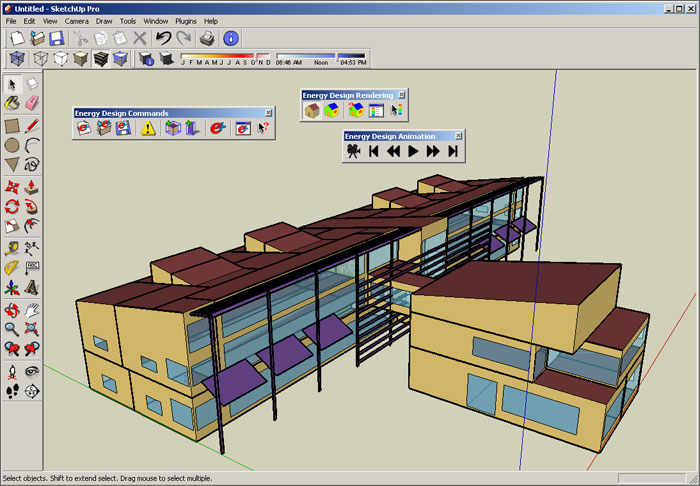This article is part of BD+C's special five-part Technology Report 2014: Top tech tools and trends for AEC professionals.
For more than a decade, the U.S. Department of Energy has made its EnergyPlus energy analysis and thermal load simulation program available for free to Building Teams.
Using EnergyPlus, AEC professionals can model heating, cooling, lighting, ventilation, and other energy flows, as well as water consumption, within a building design.
But without a major rewrite of the program since its creation, using EnergyPlus could exhibit slow performance and occasionally inaccurate analysis results.
The programming language it was originally written in, Fortran, simply could not keep up with advances in the hardware and software computing environment. FORTRAN is a language aimed at scientific programs to be run by scientists for days and weeks on supercomputers, not by building designers running multiple iterations of a design idea in a matter of a few hours.
Because it wasn't well integrated with common architectural design software, EnergyPlus never gained widespread adoption by architects working in the conceptual stage of a project.
At Greenbuild 2013, Autodesk (working pro bono) turned over brand new engine source code to the DOE to create a completely rewritten EnergyPlus for a forthcoming version. The new code will be made available under the DOE’s open source license.
Autodesk’s software engineers translated EnergyPlus—more than 600,000 lines of code—to C++, a modern, object-oriented language that is better supported on mass-market hardware and software platforms.
As a result, a larger ecosystem of developers and vendors will be able to contribute updates to the code in order to improve performance and decrease the time required to run energy model simulations.
The forthcoming version will also work better with BIM applications, auditing tools, and energy dashboards after it is released and developers are able to work on improved integrations.
For more, visit: http://apps1.eere.energy.gov/buildings/energyplus.
Related Stories
| Sep 13, 2010
Richmond living/learning complex targets LEED Silver
The 162,000-sf living/learning complex includes a residence hall with 122 units for 459 students with a study center on the ground level and communal and study spaces on each of the residential levels. The project is targeting LEED Silver.
| Sep 13, 2010
World's busiest land port also to be its greenest
A larger, more efficient, and supergreen border crossing facility is planned for the San Ysidro (Calif.) Port of Entry to better handle the more than 100,000 people who cross the U.S.-Mexico border there each day.
| Sep 13, 2010
Triple-LEED for Engineering Firm's HQ
With more than 250 LEED projects in the works, Enermodal Engineering is Canada's most prolific green building consulting firm. In 2007, with the firm outgrowing its home office in Kitchener, Ont., the decision was made go all out with a new green building. The goal: triple Platinum for New Construction, Commercial Interiors, and Existing Buildings: O&M.
| Sep 13, 2010
Stadium Scores Big with Cowboys' Fans
Jerry Jones, controversial billionaire owner of the Dallas Cowboys, wanted the team's new stadium in Arlington, Texas, to really amp up the fan experience. The organization spent $1.2 billion building a massive three-million-sf arena that seats 80,000 (with room for another 20,000) and has more than 300 private suites, some at field level-a first for an NFL stadium.
| Sep 13, 2010
'A Model for the Entire Industry'
How a university and its Building Team forged a relationship with 'the toughest building authority in the country' to bring a replacement hospital in early and under budget.
| Sep 13, 2010
Committed to the Core
How a forward-looking city government, a growth-minded university, a developer with vision, and a determined Building Team are breathing life into downtown Phoenix.
| Sep 13, 2010
Conquering a Mountain of Construction Challenges
Brutal winter weather, shortages of materials, escalating costs, occasional visits from the local bear population-all these were joys this Building Team experienced working a new resort high up in the Sierra Nevada.
| Sep 13, 2010
Data Centers Keeping Energy, Security in Check
Power consumption for data centers doubled from 2000 and 2006, and it is anticipated to double again by 2011, making these mission-critical facilities the nation's largest commercial user of electric power. With major technology companies investing heavily in new data centers, it's no wonder Building Teams see these mission-critical facilities as a golden opportunity, and why they are working hard to keep energy costs at data centers in check.
| Sep 13, 2010
3D Prototyping Goes Low-cost
Today’s less costly 3D color printers are attracting the attention of AEC firms looking to rapidly prototype designs and communicate design intent to clients.
| Aug 11, 2010
Cubellis principals reorganize as CI design
Former principals of Cubellis Inc. have formed ci design "with a stellar group of projects in the United States and internationally," states John Larsen who, with Richard Rankin and Christopher Ladd, is leading the architecture and planning firm.
















